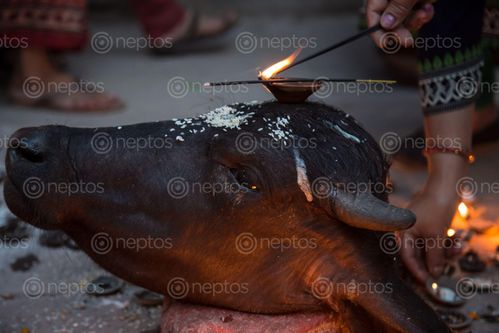
lndrajatra or Yenya Punhi is one such festival that takes us back to Medieval Nepal and provides us the opportunity to relive the life of our ancestors. But in the meantime it is also redrawing its identity in the space that we have modified, to be a“modern city” which was created thousands of years back.But these aspects of intangible heritage – festivals, rituals, and practices which were started hundreds of years back continue to exist in the present changed and altered ancient city. Some of the rituals and festivals are being abandoned due to several reasons but we still have many, which we proudly celebrate. One of such festival is Yenya and let us look into some aspects of Yenya in today’s urban space and how it is still reminding us consciously or unconsciously of how we mark the present with the memories of the past. Upakhu is the ritual where the familyof the deceased people on that year goes around the city (in clockwise direction) on the evening of the first day of the Jatra, placing the paalchha (butter lamp in the raw earthen bowl) along the path.This ritual is also known as Paalchha Biyounu – meaning to distribute or place paalchha. People also place paalchha on the shrines and temples on the way and even offer paalchha to some relatives who happen to be watching the procession. This light from the lamp is believed to show the way to the deceased people’s spirits to the heaven, and this procession wards off evil spirits from the city. Local Guthi members with traditional music also join the procession. The locality of this route welcomes people participating in the procession by cleaning and decorating their place and temples as well as placing a huge heap of samaye baji. According to well-known art historian and anthropologist author Mary Slusser, Kathmandu used to have a wall around the city and people on that day still follow the boundary where the wall stood. With the fall of the city wall after the Gorkhali invasion in Kathmandu, people have lost the sense of boundaries as well but the ritual, which we continue, still reminds of the old boundaries. It is still common to refer the newer settlements outside of ancient city boundary as desha pine meaning outside of the city. Older generations believed that impure and evil spirits reside outside of the city boundary while the city area remains pure. This might be one of the reasons that the mask dances of this festival of Kathmandu go outside of the old city boundary and when asked they mention they are not allowed to cross the river. Settlements were concentrated in the old city surrounded by the vast green fields for a very long time. This reason of impurity protected the fertile land of Kathmandu Valley avoiding the rampant construction of houses unlike today. - Monalisa Maharjan
